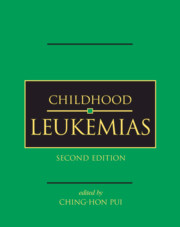Book contents
- Frontmatter
- Contents
- List of contributors
- Preface
- Part I History and general issues
- Part II Cell biology and pathobiology
- 4 Anatomy and physiology of hematopoiesis
- 5 Hematopoietic growth factors
- 6 Signal transduction in the regulation of hematopoiesis
- 7 Immunophenotyping
- 8 Immunoglobulin and T-cell receptor gene rearrangements
- 9 Cytogenetics of acute leukemias
- 10 Molecular genetics of acute lymphoblastic leukemia
- 11 Molecular genetics of acute myeloid leukemia
- 12 Apoptosis and chemoresistance
- 13 Heritable predispositions to childhood hematologic malignancies
- Part III Evaluation and treatment
- Part IV Complications and supportive care
- Index
- Plate Section between pages 400 and 401
- References
5 - Hematopoietic growth factors
from Part II - Cell biology and pathobiology
Published online by Cambridge University Press: 01 July 2010
- Frontmatter
- Contents
- List of contributors
- Preface
- Part I History and general issues
- Part II Cell biology and pathobiology
- 4 Anatomy and physiology of hematopoiesis
- 5 Hematopoietic growth factors
- 6 Signal transduction in the regulation of hematopoiesis
- 7 Immunophenotyping
- 8 Immunoglobulin and T-cell receptor gene rearrangements
- 9 Cytogenetics of acute leukemias
- 10 Molecular genetics of acute lymphoblastic leukemia
- 11 Molecular genetics of acute myeloid leukemia
- 12 Apoptosis and chemoresistance
- 13 Heritable predispositions to childhood hematologic malignancies
- Part III Evaluation and treatment
- Part IV Complications and supportive care
- Index
- Plate Section between pages 400 and 401
- References
Summary
Introduction
Hematopoiesis is regulated through the interaction of one or more of approximately 60 hematopoietic growth factors with their cogent receptors. Over the past several years, virtually all of the biologically defined hematopoietic growth factor activities have been cloned and characterized. In addition, virtually all of the receptors for these growth factors have been cloned and extensively characterized with regard to the signal transduction pathways they activate. The availability of such information has led to a number of important generalizations that provide important insights into the evolution and biology of these growth factors. This chapter focuses on these principles and provides references to reviews that cover individual cytokines in considerably more detail than is possible here. Unfortunately, due to the isolation of hematopoietic cytokines in an environment of scant information relating to their origin and functional relationships, the cytokine nomenclature has presented the most arduous task in dealing with the field. In today's world, it has become clear that groups of cytokines are related structurally, presumably reflecting their evolutionary relationships. Indeed, cytokines are related with regard to the families of receptors that they utilize and, in turn, have many functionally similar properties (Fig. 5.1). For example, the vast majority of hematopoietic cytokines (examples include interleukin-2 and erythropoietin-3) are structurally characterized by a four α-helical bundle structure and functionally related by the utilization of receptors of the cytokine receptor superfamily.
- Type
- Chapter
- Information
- Childhood Leukemias , pp. 106 - 124Publisher: Cambridge University PressPrint publication year: 2006



